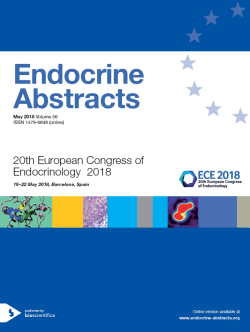
20th European Congress of Endocrinology
Barcelona,
Spain
19 May 2018 - 22 May 2018
Oral Communications
Genetic and environmental determinants of obesity and insulin resistance
ea0056oc6.1 | Genetic and environmental determinants of obesity and insulin resistance | ECE2018
5β-reductase (AKR1D1) is a potent regulator of hepatic insulin sensitivity, carbohydrate and lipid metabolism in vitro and in vivo
Nikolaou Nikolaos , Gathercole Laura , Marchand Lea , Althari Sara , Green Charlotte , McNeil Catriona , Harris Shelley , van de Bunt Martijn , Arlt Wiebke , Hodson Leanne , Tomlinson Jeremy
ea0056oc6.2 | Genetic and environmental determinants of obesity and insulin resistance | ECE2018
Deep transcranial magnetic stimulation acutely modulates neuro-endocrine pathways underlying obesity
Ferrulli Anna , Adamo Michela , Massarini Stefano , Luzi Livio
ea0056oc6.3 | Genetic and environmental determinants of obesity and insulin resistance | ECE2018
Visceral fat assessment in lamin A/C mutation carriers: phenotype –genotype correlation
Kwapich Maxime , Espiard Stephanie , Le Mapihan Kristell , Vigouroux Corinne , Vantyghem Marie-Christine
ea0056oc6.4 | Genetic and environmental determinants of obesity and insulin resistance | ECE2018
Anthropometric measurements and metabolic syndrome in relation to glucocorticoid receptor polymorphisms in (local) corticosteroid users
Savas Mesut , Wester Vincent L. , Iyer Anand M. , van den Akker Erica L.T. , van Rossum Elisabeth F.C.
ea0056oc6.5 | Genetic and environmental determinants of obesity and insulin resistance | ECE2018
Associations of different body fat deposits with serum 25-hydroxyvitamin D concentrations
Rafiq Rachida , Walschot Floor , Lips Paul , Lamb Hildo , de Roos Albert , Rosendaal Frits , den Heijer Martin , de Jongh Renate , de Mutsert Renee



